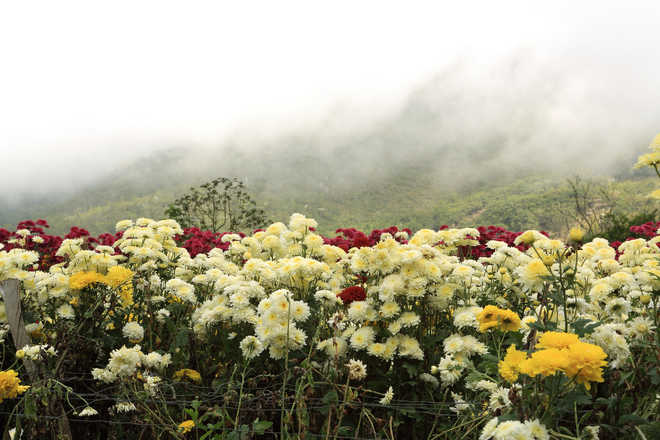Right time to plant chrysanthemum
The rainy season is also the perfect time for flower enthusiasts to prepare for one of the most spectacular winter flowers — chrysanthemum. It is a herbaceous perennial, which survives winter chill spectacularly during late November and early December.
While a keen gardener must have already planted the cuttings in early July, which will now be ready to be transplanted into pots, others who do not have their mother stock should visit nurseries to purchase the seedlings.
Selecting the right variety means that one should be aware of the form and colour of the variety which you want to purchase in order to create the desired effect.
The first thing to keep in mind is to visit only nurseries of repute so that you get only the desired varieties. Secondly, these days a vast range of varieties are available and at times it is not possible to remember and get them everywhere, therefore once in the nursery the buyer should ask for the photographs of the variety which they are selecting to buy. This way they can visualise the form and colour of the variety. Nursery staff source rooted cuttings from large producers from far off places and most of these come in thumb pots. Professional nurseries keep their stocks well marked, labeled and supported by a pictorial catalogue.
Chrysanthemum is available in basically two types, Standard variety and Spray variety. In standard variety there are further sub types such as Reflex, Incurving, Anemone, Spoon Spider, Pompon, Button, Korean Single and Korea Double.
Clay pots of size 10” to 12 “ are generally used for planting. Plant 3-5 plants of standard variety in one pot. It is mandatory to rotate pots every 2-3 days for a uniform flowering.
Chrysanthemum is quite prone to diseases, therefore, the pot mixture must be prepared during peak summer and be solar sterlised. The pot mixture should consists of, one part of garden soil, one part of farm yard manure, two part of leaf mould, two table spoon of bone meal. While planting the rooted cuttings add DAP and administer a dose of Captain (0.3 %) 2 ml in one liter of water to avoid rotting of cuttings.
Chrysanthemum is sensitive to water, therefore, irrigation should be done very carefully and totally on need basis only 2-3 times a week. Strictly avoid over watering and immediately drain excess of rain water accumulated in pots. Excessive watering causes rotting of roots and yellowing of leaves.
Pinching is done to the main stem to promote the side branching and number of flowers. It is done when the plant is 8-10 cm tall and a tip of the main stem about 3-5 cm. In standard varieties if only one flower is required no pinching is required but de-budding and de-shooting is required to be done as and when required.
Staking is done to support to the growing stem and curtailing the spread of the plant. Staking is done preferably with strong, split bamboo stakes which are inserted deep enough in the compost to support the grown up plant. Be careful not to damage the roots.
To enjoy a healthy bloom, a fortnightly dose of liquid manure should be administered till bud formation or alternatively 2 gram of urea dissolved in one liter of water can be given. Ensure that the liquid does not spill on the leaves else it will burn them. Fortnight application of NPK is also beneficial.
Tips
Chrysanthemum pots should never be kept where there is night illumination.
n Always buy extra seedling for unforeseen loss of plant.
n For a uniform flowering it is mandatory to rotate pots every 2-3 days.
n Blooming depends upon the variety of the Chrysanthemum.
n Once the blooming starts continuous removal of spent flowers should be done.
Liquid manure is prepared by fermentation. Take about two kg of fresh cow dung alternatively farm yard manure in ten liters of water. Water is filled in a big container and cow dung is put in a muslin cloth and suspended in the water container for 5-7 days. The liquid is then diluted to tea color and put 500 ml to one liter per pot.









